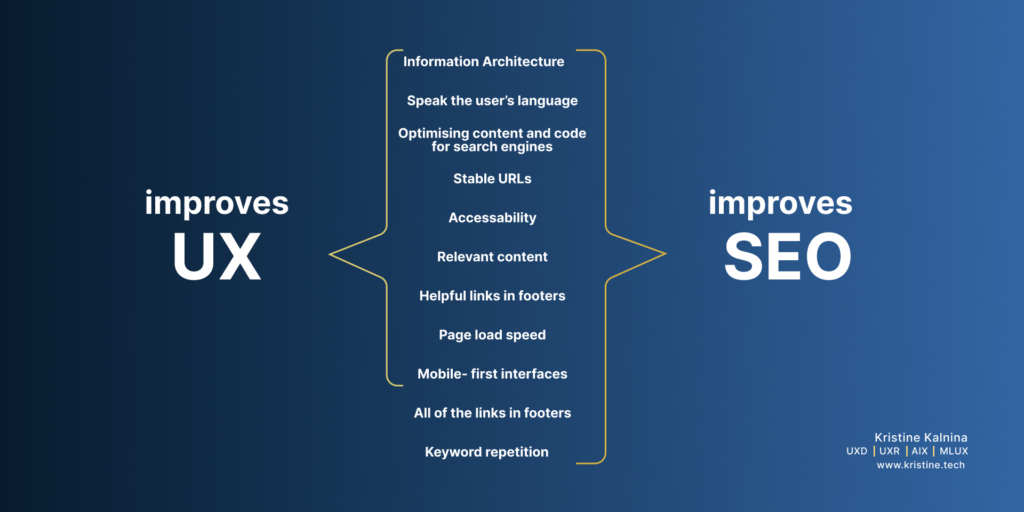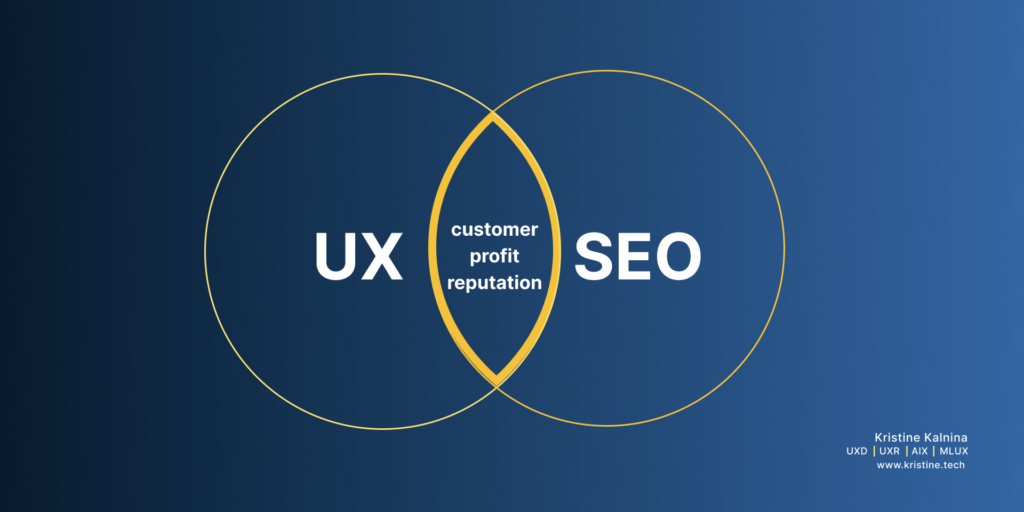Discover how the marriage of user experience and search engine optimization can boost your website’s performance to new heights.

Image courtesy of via DALL-E 3
Table of Contents
Welcome to the exciting world where UX meets SEO! In this blog post, we will explore how User Experience (UX) and Search Engine Optimization (SEO) come together to enhance website performance. Understanding how UX and SEO intersect is crucial for creating a website that not only looks great but also ranks well in search engine results.
What is UX?
UX stands for User Experience, which refers to the journey that a user takes while interacting with a website. It encompasses how easily a user can navigate a site, find information, and accomplish tasks. A positive UX ensures that users enjoy their time on a website and are more likely to return in the future.
What is SEO?
SEO stands for Search Engine Optimization, a set of practices aimed at improving a website’s visibility in search engine results. When a website is optimized for SEO, it is more likely to appear higher in search results, making it easier for users to find. This, in turn, drives more traffic to the site.
Now that we understand the basics of UX and SEO, let’s delve deeper into how these two elements work together to improve website performance.
Why Good UX is Important for SEO
User Engagement
Imagine you visit a website looking for information about your favorite video game. The site is easy to navigate, the colors are pleasing, and you find what you need quickly. How would you feel? Happy, right? That’s because good User Experience (UX) makes users happy, and happy users stay longer on a website. When users spend more time on a site, it tells search engines that the site is valuable, leading to better rankings. So, when a website is enjoyable to use, everyone wins!
Reduced Bounce Rates
Have you ever clicked on a website link, only to leave immediately because it took forever to load or was confusing? When this happens, it’s called a “bounce.” Good UX helps prevent bounces by ensuring that users stay on a site longer. With clear navigation, easy-to-find information, and a pleasing design, users are more likely to stick around. Low bounce rates signal search engines that the site is relevant, boosting its ranking. So, when a website keeps users engaged, it’s a win-win for both users and search engines!
When it comes to boosting your website’s performance, there are key UX elements that also have a significant impact on SEO. Ensuring that your website is user-friendly and provides a positive experience not only keeps visitors happy but also improves your search engine rankings.
Page Speed
Page speed is a crucial UX element that plays a vital role in SEO. Fast-loading pages keep users satisfied and engaged, reducing bounce rates and increasing the likelihood of them staying longer on your site. Search engines like Google also favor websites that load quickly, making it essential to optimize your site’s speed for better SEO performance.
Mobile-Friendly Design
Having a website that is mobile-friendly is not only important for user experience but also for SEO. With the increasing number of users accessing websites on mobile devices, having a responsive design that works well across all screen sizes and devices is essential. Search engines now prioritize mobile-friendly websites in their rankings, making it crucial to ensure that your site is optimized for mobile users.
Clear Navigation
Clear and easy-to-use site navigation is another key UX element that impacts SEO. Providing users with intuitive navigation helps them find the information they are looking for quickly and easily. This, in turn, increases user engagement and time spent on your site, signaling to search engines that your content is valuable and relevant. Optimizing your site’s navigation can improve both user experience and SEO performance.
Quality Content
Quality content is at the core of both UX and SEO. Creating useful, original, and engaging content not only keeps users interested and coming back for more but also helps your site rank higher in search engine results. Search engines prioritize websites that provide valuable and relevant content to users, making it essential to focus on creating high-quality content that meets the needs of your audience.
SEO Practices that Enhance UX
In order to improve the user experience (UX) on your website, it is important to implement specific Search Engine Optimization (SEO) practices that enhance the overall usability and satisfaction of your visitors. By focusing on these SEO strategies, you can ensure that users not only find your website easily but also have a positive experience while navigating through it.
Using Keywords Wisely
Keywords are the terms and phrases that users type into search engines to find relevant information. By strategically incorporating these keywords into your website content, you can make it easier for users to discover your site when searching online. This not only benefits your SEO efforts but also helps users find the information they are looking for more efficiently.
Effective Meta Descriptions
Meta descriptions are short summaries that appear below the title of a webpage in search engine results. By creating compelling and relevant meta descriptions, you can attract users to click on your link and visit your site. This not only improves your SEO by increasing your click-through rate but also provides users with a preview of what to expect on your webpage.
Proper Internal Linking
Internal linking refers to the practice of adding hyperlinks to other pages within your website. By guiding users to related articles or content on your site, you can make it easier for them to navigate and explore different sections. This not only enhances the user experience by providing valuable information but also improves SEO by increasing the time users spend on your site.
Clear Headings and Subheadings
Headings and subheadings break up your content into organized sections, making it easier for users to scan and understand the information on your webpage. By using clear and descriptive headings, you can help users quickly find the content that is most relevant to them. This not only improves the readability of your website but also enhances the overall user experience by presenting information in a structured and user-friendly manner.
Tools to Measure UX and SEO Performance
When it comes to improving the performance of your website, it’s essential to have the right tools at your disposal to measure both User Experience (UX) and Search Engine Optimization (SEO). These tools offer valuable insights into how users interact with your site and how well it ranks in search results. Let’s explore some key tools and techniques that can help you assess and enhance both UX and SEO:

Image courtesy of uxmag.com via Google Images
Google Analytics
One of the most powerful tools for tracking website performance is Google Analytics. This tool provides detailed data on user behavior, traffic sources, conversion rates, and more. By analyzing this information, you can gain valuable insights into how users engage with your site and identify areas for improvement to enhance both UX and SEO.
Use of Heatmaps
Heatmaps are graphical representations that visually display where users click, move, and scroll on a webpage. By using heatmaps, you can see which areas of your site attract the most attention and which are often ignored. This data can help you optimize your layout, design, and content to improve user engagement and ultimately boost SEO performance.
A/B Testing
A/B testing is a method that allows you to compare two versions of a webpage to see which one performs better in terms of user engagement and conversion rates. By creating different variations of a page and testing them with real users, you can identify the most effective design, content, and layout choices that drive both UX and SEO success.
Common UX Mistakes that Harm SEO
A cluttered design can be overwhelming for users, making it difficult for them to navigate your website. When there is too much information, graphics, or pop-ups on a page, users may feel confused and frustrated, leading them to leave your site quickly. This high bounce rate signals search engines that users are not finding your site helpful, which can negatively impact your SEO rankings.
Poor Readability
Text that is hard to read can be a major turn-off for users. Whether it’s due to small font sizes, low contrast between text and background, or long blocks of unbroken text, poor readability can discourage users from engaging with your content. If users struggle to understand your information, they are likely to look elsewhere for easier-to-read content, affecting your site’s user experience and ultimately hurting your SEO performance.
Slow Loading Speed
Slow-loading pages frustrate users and lead to a poor user experience. In today’s fast-paced digital world, users expect websites to load quickly, and if they have to wait too long for a page to load, they are likely to abandon it and look for a faster alternative. Search engines take into account page speed as a ranking factor, so a slow website can result in lower rankings and decreased organic traffic.
Non-Responsive Design
A non-responsive website design does not adapt well to different devices and screen sizes, such as smartphones and tablets. This can result in a disjointed and subpar user experience for visitors accessing your site from mobile devices. With a growing number of users browsing the web on their phones, having a non-responsive design can lead to higher bounce rates, lower engagement, and ultimately harm your SEO rankings.
Case Studies: Success Stories of Integrating UX and SEO
Let’s take a look at a successful e-commerce website that decided to revamp its user experience to enhance its search engine optimization. By focusing on improving the website navigation, simplifying the checkout process, and optimizing product descriptions with relevant keywords, this e-commerce site saw a significant boost in its search rankings and an increase in conversions. Users found it easier to browse through products, leading to a decrease in bounce rates and an increase in purchase completion rates.

Image courtesy of uxmag.com via Google Images
Example 2: Educational Blog
Another inspiring example is an educational blog that decided to prioritize user experience alongside its search engine optimization efforts. By incorporating clear and informative headings, internal linking to relevant resources, and creating engaging and valuable content, this blog saw a surge in organic traffic and user engagement. Visitors spent more time on the site, leading to a higher retention rate and an improvement in search engine rankings.
Steps to Improve Both UX and SEO
When it comes to enhancing your website’s performance, improving both User Experience (UX) and Search Engine Optimization (SEO) is key. By focusing on these two aspects simultaneously, you can attract more visitors, keep them engaged, and boost your site’s visibility in search results. Here are some actionable steps to help you improve both UX and SEO on your website:
Step 1: Conduct User Research
Understanding your audience is crucial for optimizing both UX and SEO. Conduct user research to gather insights about your visitors’ preferences, behaviors, and needs. By knowing your audience better, you can tailor your content, design, and navigation to meet their expectations, leading to improved user satisfaction and search engine visibility.
Step 2: Optimize for Mobile
In today’s digital landscape, making sure your website is mobile-friendly is essential for both UX and SEO. With more users accessing the internet through mobile devices, having a responsive design that adapts seamlessly to different screen sizes is paramount. Google also prioritizes mobile-friendly sites in its search results, making mobile optimization a critical factor for SEO success.
Step 3: Improve Loading Times
Website speed plays a significant role in user experience and search engine rankings. Slow-loading pages frustrate visitors and drive them away, leading to higher bounce rates and lower SEO performance. To improve loading times, consider optimizing images, leveraging browser caching, and minimizing unnecessary scripts. Faster websites not only keep users engaged but also rank better in search results.
Step 4: Create Quality Content
Content is king when it comes to both UX and SEO. To engage your audience and attract search engine traffic, focus on producing high-quality, relevant, and valuable content. By addressing your visitors’ needs and interests, you can keep them on your site longer, increase user satisfaction, and improve your site’s authority and visibility in search results. Remember, quality content is the foundation of a successful website.
Conclusion
In conclusion, the intersection of User Experience (UX) and Search Engine Optimization (SEO) plays a vital role in enhancing website performance. By understanding and implementing key elements of UX that impact SEO, businesses can improve user satisfaction, boost search engine rankings, and ultimately drive more traffic to their websites. The seamless integration of UX and SEO not only benefits users by providing a more enjoyable browsing experience but also helps businesses achieve their digital marketing goals.

Image courtesy of www.hivedigital.com via Google Images
By focusing on user engagement, reducing bounce rates, optimizing page speed, ensuring mobile-friendly design, implementing clear navigation, creating quality content, using keywords strategically, crafting effective meta descriptions, incorporating proper internal linking, and utilizing clear headings and subheadings, websites can enhance both their UX and SEO performance simultaneously.
Furthermore, through the use of tools like Google Analytics, heatmaps, and A/B testing, businesses can measure and analyze user behavior, optimize website performance, and make data-driven decisions to continuously improve their online presence. Avoiding common UX mistakes such as cluttered design, poor readability, slow loading speeds, and non-responsive design is essential in maintaining a positive user experience and preventing negative impacts on SEO.
By learning from successful case studies and following actionable steps to improve both UX and SEO, businesses can create a winning digital strategy that resonates with users and search engines alike. The benefits of integrating UX and SEO are clear: increased visibility in search results, higher user engagement, improved conversion rates, and ultimately, better business outcomes.
Want to turn these SEO insights into real results? Seorocket is an all-in-one AI SEO solution that uses the power of AI to analyze your competition and craft high-ranking content.
Seorocket offers a suite of powerful tools, including a Keyword Researcher to find the most profitable keywords, an AI Writer to generate unique and Google-friendly content, and an Automatic Publisher to schedule and publish your content directly to your website. Plus, you’ll get real-time performance tracking so you can see exactly what’s working and make adjustments as needed.
Stop just reading about SEO – take action with Seorocket and skyrocket your search rankings today. Sign up for a free trial and see the difference Seorocket can make for your website!
Frequently Asked Questions (FAQs)
How does UX affect SEO?
UX, which stands for User Experience, plays a crucial role in SEO, or Search Engine Optimization. When a website is user-friendly, easy to navigate, and provides valuable content, users are more likely to stay longer on the site. Search engines like Google take note of this positive user behavior and reward the site with higher rankings in search results. So, by focusing on creating a great user experience, you can actually boost your SEO performance!
Can I improve both UX and SEO at the same time?
Absolutely! Improving both user experience and search engine optimization can go hand in hand. By incorporating strategies like optimizing your website for mobile devices, creating quality content, and using the right keywords, you can enhance both aspects simultaneously. With a holistic approach that considers the needs of both users and search engines, you can achieve better results across the board.
What tools can help with UX and SEO?
There are several tools available to help you measure and improve both UX and SEO on your website. Google Analytics is a powerful tool that provides insights into user behavior, traffic sources, and website performance. You can also use heatmaps to see where users click and scroll on your pages, helping you identify areas for improvement. A/B testing is another valuable technique that allows you to compare different versions of a webpage to see which performs better in terms of both user experience and SEO.







